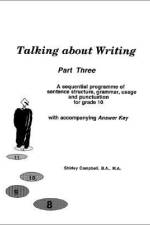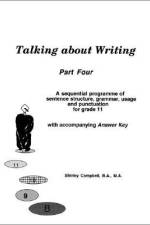von Shirley Campbell B. a. M. a.
23,00 €
Talking about Writing is for high school teachersand students who 1. need a common vocabulary with which to discuss written language; 2. desire a working knowledge of the chief elements of sentence structure, grammar, usage and punctuation as they apply to the writing process; 3. demand an integrated approach, and a sequenced format adaptable to individual lessons; and 4. appreciate the help of an Answer key. A mechanic immersed in the intricacies of engine repair doesnot ask for a "thingummy" or a "whatsit."He or she names the tool and holds out a hand to receive it.In the same way, teachers and students poring over the productsof the writing process need a basic common vocabulary withwhich to discuss the work. They need to make mutually understandablestatements which will clarify and improve the material under review.For example, "This sentence contains a misplaced modifier"is more helpful and precise than 'Don't you think puttingthis bit in a different place will make the sentence sound better?'Talking about Writing supplies this basic vocabulary.The text has a simple format. It teaches the recognition ofthe nine sentence errors which writers commonly make. Itintegrates the grammar necessary to understand each sentenceerror. Sentence combining, usage, and punctuation exercisesstrengthen writing technique.Talking about Writing fills a need for both aconcrete objective in English language study and a teachingplan. It provides a method of entry - the nine sentence errors- which is useful to many: beginning teachers, for example; teachersof other subjects who have been asked to pick up one or two blocksof English in the timetable; teachers who wish a clear explanationof the language in the writing process; or parents who run homeschool.A further advantage is to make a connection between theteaching of English language and other languages; such as,French or Spanish. Students studying a second language are expectedto recognize, for example, a direct object or a past participlein order to make the necessary agreement. The grammar componentaccompanying each sentence error encourages the transfer of thisknowledge from one language to another.Talking about Writing is sequenced and self-explanatory.In each chapter the material progresses in simple and logicalincrements to the desired end; namely, to recognize a sentenceerror in order to discuss written work, practise effective writingtechniques, and empower communication. The sentence errors progressin difficulty from grades 8 to 12. The format is adapted forindividual lessons.Curriculum guides tend to be written in generalities. Talkingabout Writing provides the teacher with a pattern.Having experienced the focus of this programme and the integrationof the topics, he or she then knows how to access additional materialto suit a student's individual needs.How Talking about Writing is organizedStudents are taught to recognize the nine major sentence errors:two in each of grades 8 to 11, and one in grade 12, as follows: Grade 8- Run-on Sentence, Sentence Fragment Grade 9- Lack of Parallel Structure, Misplaced Modifier Grade 10- Dangling Participle, Lack of Agreement Grade 11- Indefinite Antecedent, Incorrect Tense Grade 12- Wordiness The grammar necessary to understand the sentence error is integratedwith appropriate punctuation and sentence combing techniques.A pre-test and a post-test a...




